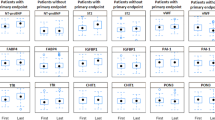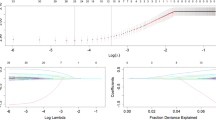de Jager, D. J. et al. Cardiovascular and noncardiovascular mortality among patients starting dialysis. JAMA 302, 1782–1789 (2009).
Article
PubMed
Google Scholar
Anker, S. D. et al. Development and validation of cardiovascular risk scores for haemodialysis patients. Int. J. Cardiol. 216, 68–77 (2016).
Article
PubMed
Google Scholar
Thamer, M. et al. Predicting early death among elderly dialysis patients: Development and validation of a risk score to assist shared decision making for dialysis initiation. Am. J. Kidney Dis. 66, 1024–1032 (2015).
Article
PubMed
PubMed Central
Google Scholar
Ma, L. & Zhao, S. Risk factors for mortality in patients undergoing hemodialysis: A systematic review and meta-analysis. Int. J. Cardiol. 238, 151–158 (2017).
Article
PubMed
Google Scholar
Lorenz, G. et al. Mortality prediction in stable hemodialysis patients is re fi ned by YKL-40, a 40-kDa glycoprotein. Kidney Int. 93, 221–230 (2018).
Article
CAS
PubMed
Google Scholar
Günthner, R. et al. Impaired retinal vessel dilation predicts mortality in end-stage renal disease. Circ. Res. 124, 1796–1807 (2019).
Article
CAS
Google Scholar
Floege, J. et al. Development and validation of a predictive mortality risk score from a European hemodialysis cohort. Kidney Int. 87, 996–1008 (2015).
Article
CAS
PubMed
PubMed Central
Google Scholar
Wang, P., Li, Y. & Reddy, C. K. Machine Learning for Survival Analysis: A Survey. ar**v:1708.04649[cs.LG] (2017) [cs.LG].
Deo, R. C. Machine learning in medicine. Circulation 132, 1920–1930 (2015).
Article
PubMed
PubMed Central
Google Scholar
Zou, H. & Hastie, T. Regularization and variable selection via the elastic net. J. R. Stat. Soc. Ser. B. Stat. Methodol. 67, 301–320 (2005).
Article
MathSciNet
MATH
Google Scholar
Meinshausen, N. & Bühlmann, P. Stability selection. J. R. Stat. Soc. Ser. B Stat. Methodol. 72, 417–473 (2010).
Article
MathSciNet
MATH
Google Scholar
Schmaderer, C. et al. Rationale and study design of the prospective, longitudinal, observational cohort study “rISk strAtification in end-stage renal disease” (ISAR) study. BMC Nephrol. 17, 1–12 (2016).
Article
Google Scholar
Liu, J., Huang, Z., Gilbertson, D. T., Foley, R. N. & Collins, A. J. An improved comorbidity index for outcome analyses among dialysis patients. Kidney Int. 77, 141–151 (2010).
Article
PubMed
Google Scholar
Cohen, L. M., Ruthazer, R., Moss, A. H. & Germain, M. J. Predicting six-month mortality for patients who are on maintenance hemodialysis. Clin. J. Am. Soc. Nephrol. 5, 72–79 (2010).
Article
PubMed
PubMed Central
Google Scholar
Keskar, V. & Sood, M. M. Use of Oral Anticoagulation in the Management of Atrial Fibrillation in Patients with ESRD : Con. 2085–2092 (2016) https://doi.org/10.2215/CJN.03200316.
Kilpatrick, R. D. et al. Association between Serum Lipids and Survival in Hemodialysis Patients and Impact of Race. 293–303 (2004) https://doi.org/10.1681/ASN.2006070795.
Ravel, V. et al. Association of aspartate aminotransferase with mortality in hemodialysis patients. Nephrol. Dial. Transplant 31, 814–822 (2016).
Article
CAS
PubMed
Google Scholar
Goldstein, B. A., Pencina, M. J., Montez-Rath, M. E. & Winkelmayer, W. C. Predicting mortality over different time horizons: Which data elements are needed?. J. Am. Med. Informatics Assoc. 24, 176–181 (2017).
Article
Google Scholar
Friedman, A. N. et al. Fatty acids and other risk factors for sudden cardiac death in patients starting hemodialysis. Am. J. Nephrol. 38, 12–18 (2013).
Article
CAS
PubMed
Google Scholar
Goldstein, B. A., Chang, T. I., Mitani, A. A., Assimes, T. L. & Winkelmayer, W. C. Near-term prediction of sudden cardiac death in older hemodialysis patients using electronic health records. Clin. J. Am. Soc. Nephrol. 9, 82–91 (2014).
Article
PubMed
Google Scholar
Tait Wojno, E. D., Hunter, C. A. & Stumhofer, J. S. The immunobiology of the interleukin-12 family: Room for discovery. Immunity 50, 851–870 (2019).
Article
CAS
PubMed
Google Scholar
Liu, J. et al. Interleukin-12: An update on its immunological activities, signaling and regulation of gene expression. Curr. Immunol. Rev. 1, 119–137 (2005).
Article
CAS
PubMed
PubMed Central
Google Scholar
Rea, I. M., McNerlan, S. E. & Alexander, H. D. Total serum IL-12 and IL-12p40, but not IL-12p70, are increased in the serum of older subjects; Relationship to CD3+ and NK subsets. Cytokine 12, 156–159 (2000).
Article
CAS
PubMed
Google Scholar
Kimmel, P. L. et al. Immunologic function and survival in hemodialysis patients. Kidney Int. 54, 236–244 (1998).
Article
CAS
PubMed
PubMed Central
Google Scholar
Memoli, B., Marzano, L., Bisesti, V., Andreucci, M. & Guida, B. Hemodialysis-related lymphomononuclear release of interleukin-12 in patients with end-stage renal disease. J. Am. Soc. Nephrol. 10, 2171–2176 (1999).
Article
CAS
PubMed
Google Scholar
Mansouri, L., Paulsson, J. M., Moshfegh, A., Jacobson, S. H. & Lundahl, J. Leukocyte proliferation and immune modulator production in patients with chronic kidney disease. PLoS ONE 8, e73141 (2013).
Article
ADS
CAS
PubMed
PubMed Central
Google Scholar
Kim, W. R., Flamm, S. L., Di Bisceglie, A. M., Bodenheimer, H. C. & Public Policy Committee of the American Association for the Study of Liver Disease. Serum activity of alanine aminotransferase (ALT) as an indicator of health and disease. Hepatology 47, 1363–1370 (2008).
Article
CAS
PubMed
Google Scholar
Rej, R. Aminotransferases in disease. Clin. Lab. Med. 9, 667–687 (1989).
Article
CAS
PubMed
Google Scholar
Hyeon, C. K. et al. Normal serum aminotransferase concentration and risk of mortality from liver diseases: Prospective cohort study. BMJ 328, 983 (2004).
Article
Google Scholar
Lee, T. H., Kim, W. R., Benson, J. T., Therneau, T. M. & Melton, L. J. Serum aminotransferase activity and mortality risk in a United States community. Hepatology 47, 880–887 (2008).
Article
PubMed
Google Scholar
Lee, H. et al. Association between change in serum aminotransferase and mortality. Medicine 95, e3158 (2016).
Article
CAS
PubMed
PubMed Central
Google Scholar
Oren, R. Serum liver enzymes—Should we count on them?. Liver Int. 34, 171–173 (2014).
Article
CAS
PubMed
Google Scholar
Wolf, P. L., Williams, D., Coplon, N. & Coulson, A. S. Low aspartate transaminase activity in serum of patients undergoing chronic hemodialysis. Clin. Chem. 18, 567–568 (1972).
Article
CAS
PubMed
Google Scholar
Sette, L. H. B. C. & de Almeida Lopes, E. P. Liver enzymes serum levels in patients with chronic kidney disease on hemodialysis: A comprehensive review. Clinics 69, 271–278 (2014).
Article
PubMed
PubMed Central
Google Scholar
Ray, L., Nanda, S. K., Chatterjee, A., Sarangi, R. & Ganguly, S. A comparative study of serum aminotransferases in chronic kidney disease with and without end-stage renal disease: Need for new reference ranges. Int. J. Appl. Basic Med. Res. 5, 31–35 (2015).
Article
CAS
PubMed
PubMed Central
Google Scholar
Kalantar-Zadeh, K., Ikizler, T. A., Block, G., Avram, M. M. & Kopple, J. D. Malnutrition-inflammation complex syndrome in dialysis patients: Causes and consequences. Am. J. Kidney Dis. 42, 864–881 (2003).
Article
PubMed
Google Scholar
Spoto, B. et al. Association of IL-6 and a functional polymorphism in the IL-6 gene with cardiovascular events in patients with CKD. Clin. J. Am. Soc. Nephrol. 10, 232–240 (2015).
Article
CAS
PubMed
Google Scholar
Bologa, R. M. et al. Interleukin-6 predicts hypoalbuminemia, hypocholesterolemia, and mortality in hemodialysis patients. Am. J. Kidney Dis. 32, 107–114 (1998).
Article
CAS
PubMed
Google Scholar
Sun, J. et al. Biomarkers of cardiovascular disease and mortality risk in patients with advanced CKD. Clin. J. Am. Soc. Nephrol. 11, 1163–1172 (2016).
Article
CAS
PubMed
PubMed Central
Google Scholar
Panichi, V. et al. Interleukin-6 is a stronger predictor of total and cardiovascular mortality than C-reactive protein in haemodialysis patients. Nephrol. Dial. Transplant. 19, 1154–1160 (2004).
Article
CAS
PubMed
Google Scholar
Wetmore, J. B. et al. Associations of interleukin-6, C-reactive protein and serum amyloid A with mortality in haemodialysis patients. Nephrology 13, 593–600 (2008).
Article
CAS
PubMed
Google Scholar
Honda, H. et al. Serum albumin, C-reactive protein, interleukin 6, and fetuin a as predictors of malnutrition, cardiovascular disease, and mortality in patients with ESRD. Am. J. Kidney Dis. 47, 139–148 (2006).
Article
CAS
PubMed
Google Scholar
Lorenz, G. et al. Worsening calcification propensity precedes all-cause and cardiovascular mortality in haemodialyzed patients. Sci. Rep. 7, 1–11 (2017).
Article
CAS
Google Scholar
Matschkal, J. et al. Comparison of 24-hour and office pulse wave velocity for prediction of mortality in hemodialysis patients. Am. J. Nephrol. 49, 317–327 (2019).
Article
PubMed
Google Scholar
Seidelmann, S. B. et al. Retinal vessel calibers in predicting long-term cardiovascular outcomes. Circulation 134, 1328–1338 (2016).
Article
PubMed
PubMed Central
Google Scholar
R Core Team. R: A Language and Environment for Statistical Computing. (R Foundation for Statistical Computing, 2020).
Sill, M., Hielscher, T., Becker, N. & Zucknick, M. c060: Extended inference with lasso and elastic-net regularized cox and generalized linear models. J. Stat. Softw. 62, 1–21 (2015).
Google Scholar
Eilers, P. H. C. & Marx, B. D. Flexible smoothing with B -splines and penalties. Stat. Sci. 11, 89–121 (1996).
Article
MathSciNet
MATH
Google Scholar
Therneau, T. M. & Grambsch, P. M. Modeling Survival Data: Extending the Cox Model (Springer New York, 2000) https://doi.org/10.1007/978-1-4757-3294-8.
Book
MATH
Google Scholar
Heagerty, P. J. & Zheng, Y. Survival model predictive accuracy and ROC curves. Biometrics 61, 92–105 (2005).
Article
MathSciNet
PubMed
MATH
Google Scholar




